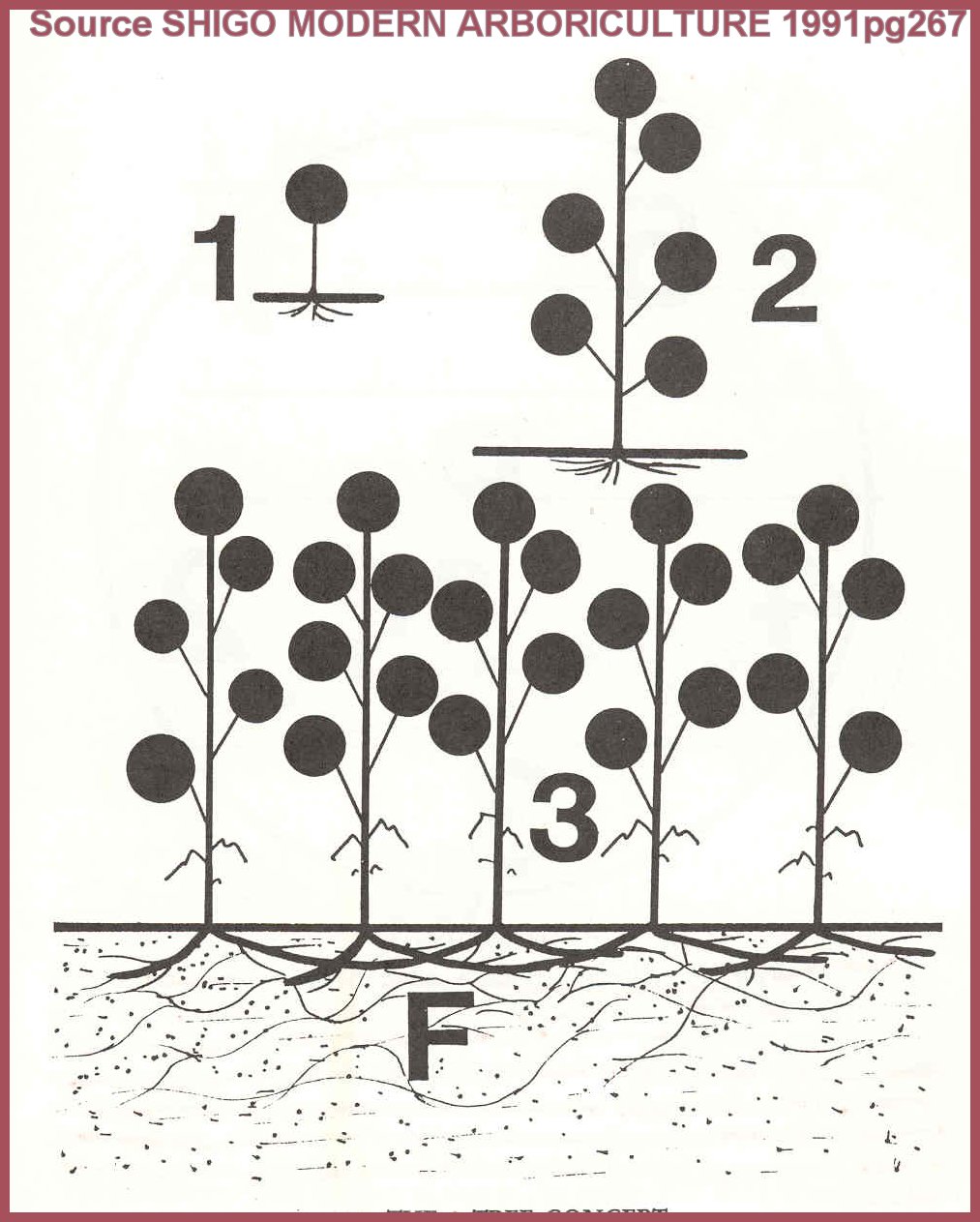

Three Tree Concept - Trees may be defined at 3 different levels: 1) Tree 1 is the young tree that is mostly branches, and branches on larger trees. 2) Tree 2 is the maturing and mature tree with a well-developed trunk and a crown of branches. Tree 2 is the tree we call a tree. 3) Tree 3 is the community tree in the forest that is connected by root grafts or by the mycorrhizal fungi [F]. Tree 3 exists only in groups and all members of the group are the same species. Trees evolved or developed in groups in forests. Even if you do not accept the 3 tree concept, it is still important to understand that when we speak of a tree, we must indicate whether we mean the individual tree- Tree l or Tree 2- or the group tree- Tree 3, or the community. The separation is essential in understanding survival factors. For example, sex is not a survival factor for the individual, but it is for the group. Pathogens are harmful to the individual, but the group requires them because they eliminate the weaklings from the group. So we see that the same factor can be good, or bad depending on whether we are considering the individual or the group. I believe the picture becomes much clearer when we consider 3 trees. The young tree is mostly branches. Almost all the wood that is in the young tree is dynamic mass-wood with living cells. The ratio of dynamic mass to static mass-wood without living cells-begins to change as the tree grows older, and especially as the trunk becomes a more prominent feature or part of the plant. The branch, or Tree 1 must always provide energy for the tree parts that can not manufacture food- the maturing trunk and roots- and for itself. The energy flow is to the other parts before it goes to the branches, it begins to shed parts of itself to reduce its dynamic mass. Many pathogens attack Tree 1 as it becomes weaker. When the pathogens drain the remaining energy from Tree 1, or when Tree 1 ages rapidly as energy is decreased, the trunk and branch are separated by a boundary that forms at the base of Tree 1, at the base of the branch. As indicated, there are many diseases of Tree 1. There are only a few diseases of Tree 2 that can kill in relatively short time-Fire Blight, Dutch Elm Disease, Oak Wilt, Chestnut Blight, Phytopthora cinnamomi, White Pine Blister Rust, some root rots, and some other rust diseases. The numbers are still small compared to the pathogens that attack leaves, twigs, and branches- Tree 1. We are now beginning to see diseases of Tree 3 as forests are damaged repeatedly. In some tree species, especially tropical hardwoods and species of Eucalyptus, the Tree 1 and Tree 2 can be easily seen. Tree 1 reiterates Tree 2. The tree or Tree 2 appears as a framework that holds many trees - branches, or Tree 1 - that have a shape or architecture similar to the composite tree or Tree 2. Many Tree 3's have established obligatory relationships with specific root fungi, the mycorrhizae fungi. The tree is dependent on the fungi and the fungi are dependent on the tree. When one of the other departs from the relationship long enough, the normal relationship may be difficult to bring back to its original state. The fasted way to destroy an organism is to destroy its niche - the place where it lives and reproduces. The niche is altered by the presence of organisms in a manner that best suits the continued survival of the organisms.
Dictionary MAIN
PAGE
Text & Graphics Copyright © 2007
Keslick & Son Modern Arboriculture
Please report web site problems, comments and words of interest,
not found.
Contact